On March 24, 1975, the last in a long line of super successful Saturn rockets rolled out from the vehicle assembly building to Launch Pad 39B at NASA’s Kennedy Space Center in Florida. The Saturn IB rocket for the Apollo-Soyuz Test Project was the 19th in the Saturn class stacked in the assembly building, beginning in 1966 with the Saturn V 500F facilities checkout vehicle. Thirteen flight Saturn V rockets followed, 12 to launch Apollo spacecraft and one to place the Skylab space station into orbit. In addition, workers stacked four flight Saturn IB rockets, three to launch crews to Skylab and one for Apollo-Soyuz, plus another for the Skylab rescue vehicle that was not needed and never launched. Previously, workers stacked Saturn I and Saturn IB rockets on the pads at Launch Complexes 34 and 37. With the successful liftoff in July 1975, the Saturn family of rockets racked up a 100 percent success rate of 32 launches.
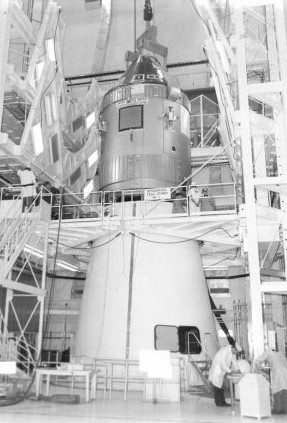 Workers lower the Apollo command and service modules onto the spacecraft adaptor.NASA
Workers lower the Apollo command and service modules onto the spacecraft adaptor.NASA 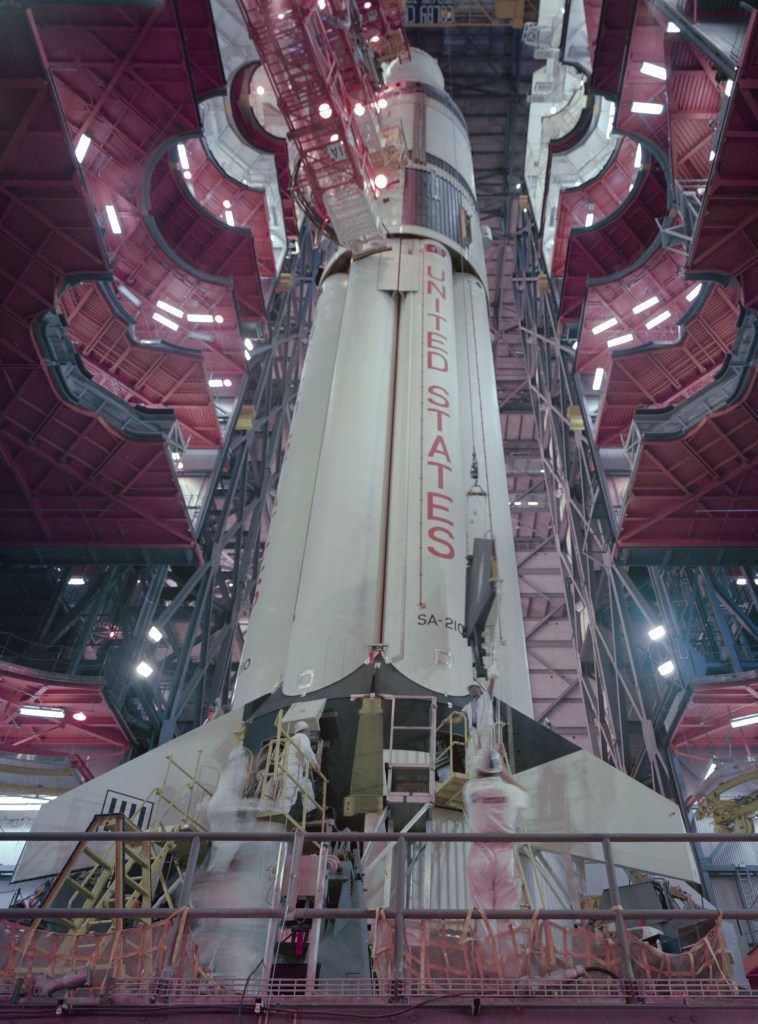 Technicians in the assembly building replace the fins on the Saturn IB rocket’s first stage. NASA
Technicians in the assembly building replace the fins on the Saturn IB rocket’s first stage. NASA 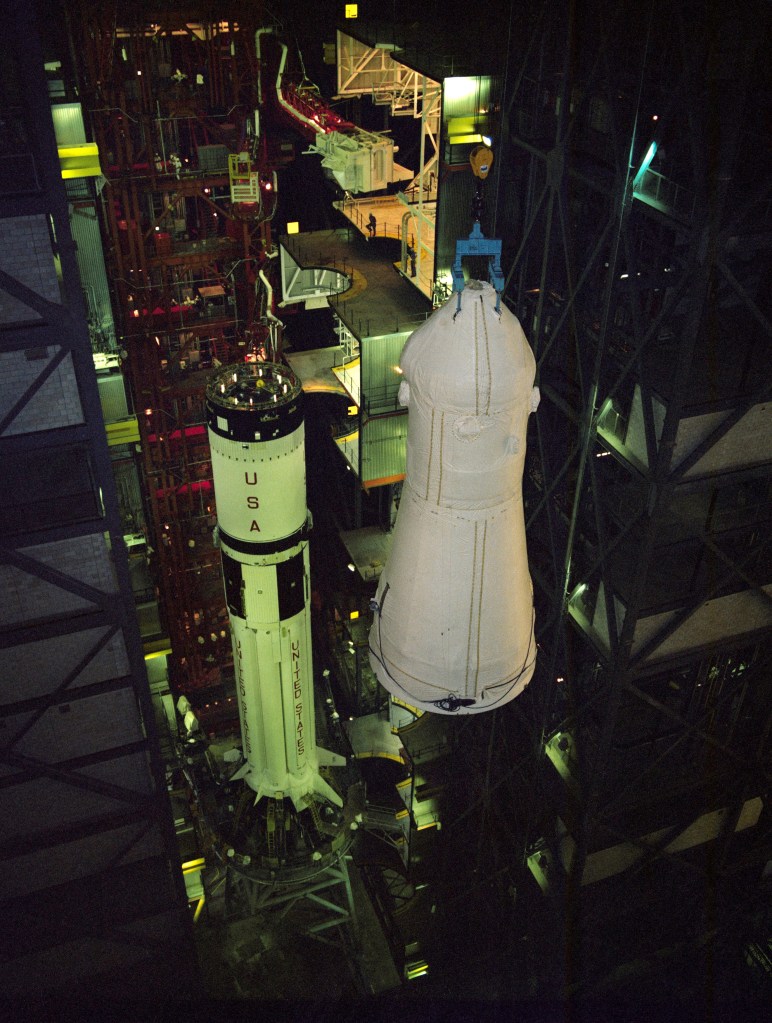 Workers in the assembly building prepare to lower the spacecraft onto its Saturn IB rocket.NASA Inspections of the Saturn IB rocket’s first stage fins revealed hairline cracks in several hold-down fittings and managers ordered the replacement of all eight fins. While the cracks would not affect the flight of the rocket they bore the weight of the rocket on the mobile launcher. Workers finished the fin replacement on March 16. Engineers in Kennedy’s spacecraft operations building prepared the Apollo spacecraft for its historic space mission. By early March, they had completed checkout and assembly of the spacecraft and transported it to the assembly building on March 17 to mount it atop the Saturn IB’s second stage. Five days later, they topped off the rocket with the launch escape system.
Workers in the assembly building prepare to lower the spacecraft onto its Saturn IB rocket.NASA Inspections of the Saturn IB rocket’s first stage fins revealed hairline cracks in several hold-down fittings and managers ordered the replacement of all eight fins. While the cracks would not affect the flight of the rocket they bore the weight of the rocket on the mobile launcher. Workers finished the fin replacement on March 16. Engineers in Kennedy’s spacecraft operations building prepared the Apollo spacecraft for its historic space mission. By early March, they had completed checkout and assembly of the spacecraft and transported it to the assembly building on March 17 to mount it atop the Saturn IB’s second stage. Five days later, they topped off the rocket with the launch escape system.
 The final Saturn IB begins its rollout from the vehicle assembly building. NASA
The final Saturn IB begins its rollout from the vehicle assembly building. NASA 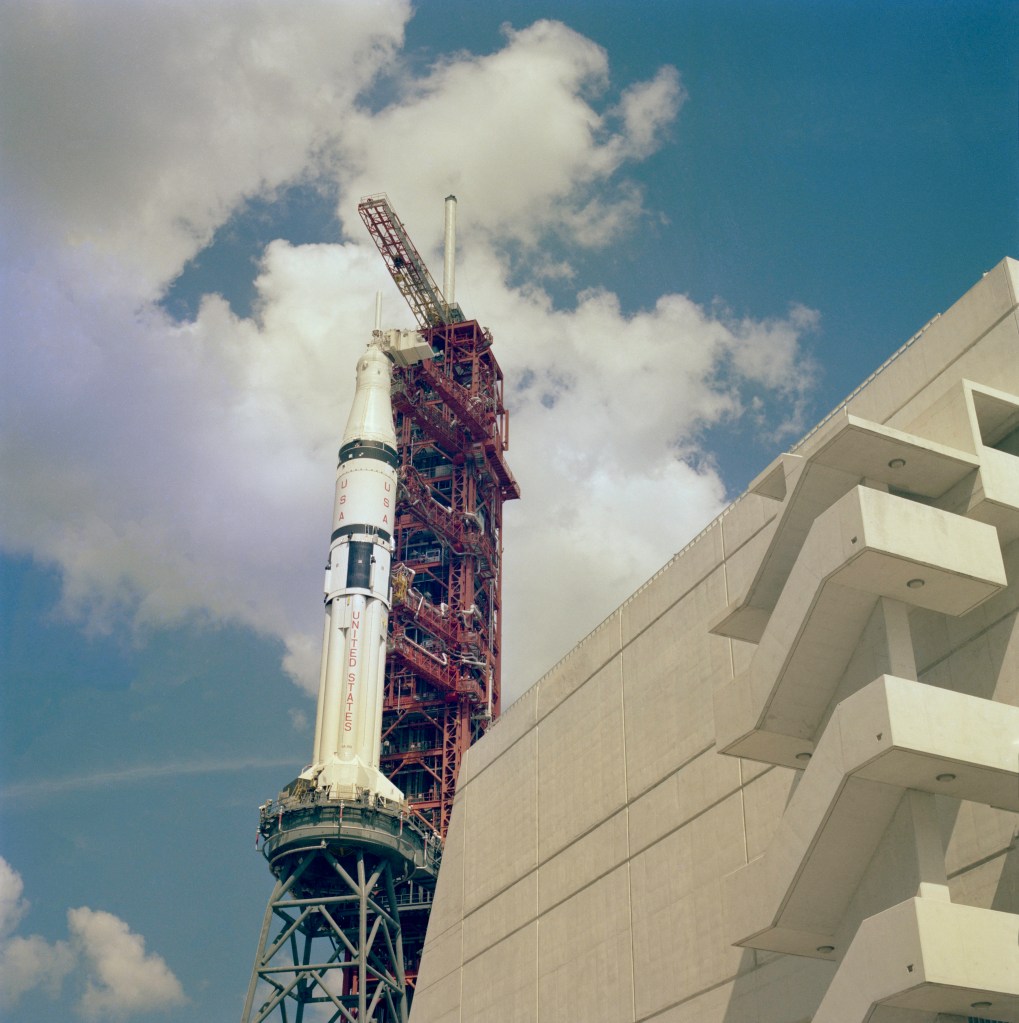 The Saturn IB passes by the Launch Control Center. NASA
The Saturn IB passes by the Launch Control Center. NASA 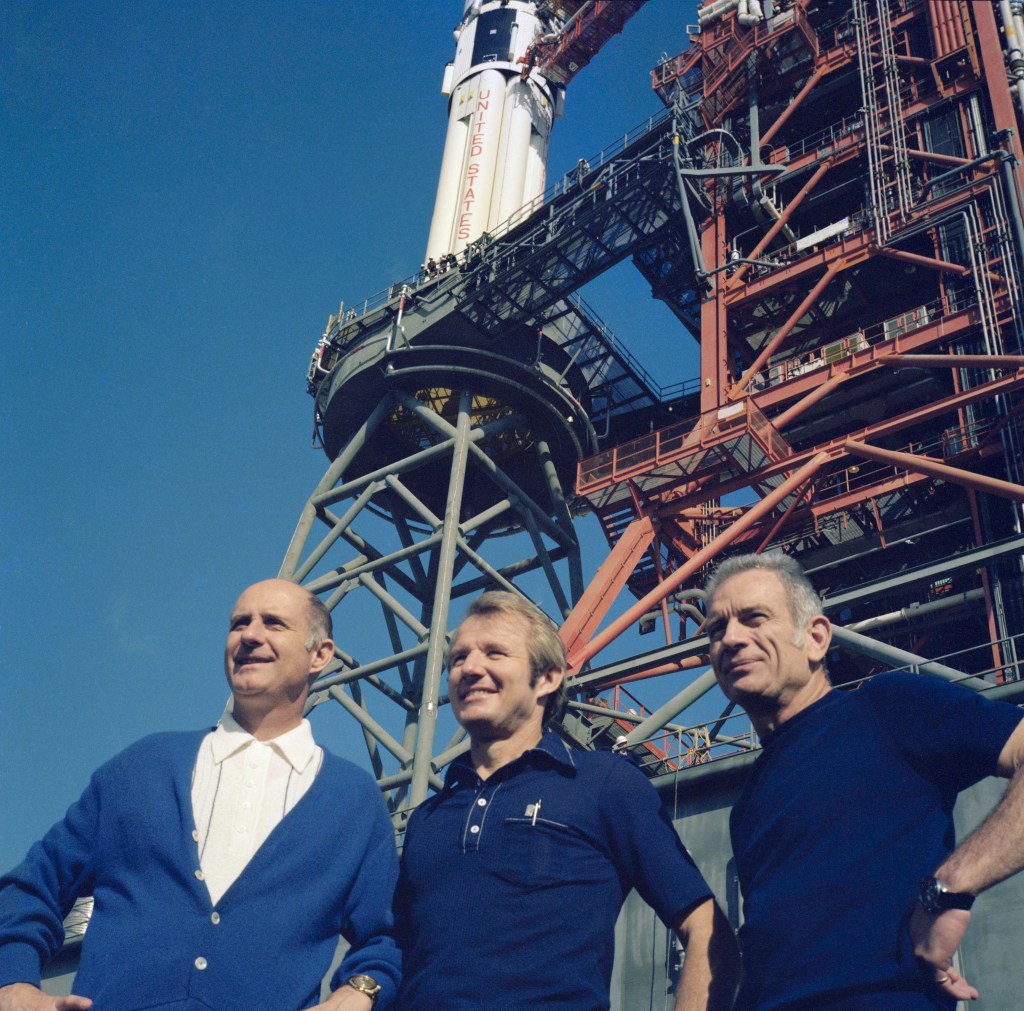 Apollo astronauts Thomas Stafford, left, Vance Brand, and Donald “Deke” Slayton pose in front of their Saturn IB during the rollout.NASA On March 23, workers edged the mobile transporter carrying the Saturn IB just outside the assembly building’s High Bay 1, where engineers installed an 80-foot tall lightning mast atop the launch tower. The next morning, the stack continued its rollout to Launch Pad 39B with the prime crew of Thomas Stafford, Vance Brand, and Donald “Deke” Slayton and support crew members Robert Crippen and Richard Truly on hand to observe. About 7,500 people, including guests, dependents of Kennedy employees and NASA Tours patrons, watched as the stack moved slowly out of the assembly building on its five-mile journey to the launch pad.
Apollo astronauts Thomas Stafford, left, Vance Brand, and Donald “Deke” Slayton pose in front of their Saturn IB during the rollout.NASA On March 23, workers edged the mobile transporter carrying the Saturn IB just outside the assembly building’s High Bay 1, where engineers installed an 80-foot tall lightning mast atop the launch tower. The next morning, the stack continued its rollout to Launch Pad 39B with the prime crew of Thomas Stafford, Vance Brand, and Donald “Deke” Slayton and support crew members Robert Crippen and Richard Truly on hand to observe. About 7,500 people, including guests, dependents of Kennedy employees and NASA Tours patrons, watched as the stack moved slowly out of the assembly building on its five-mile journey to the launch pad.
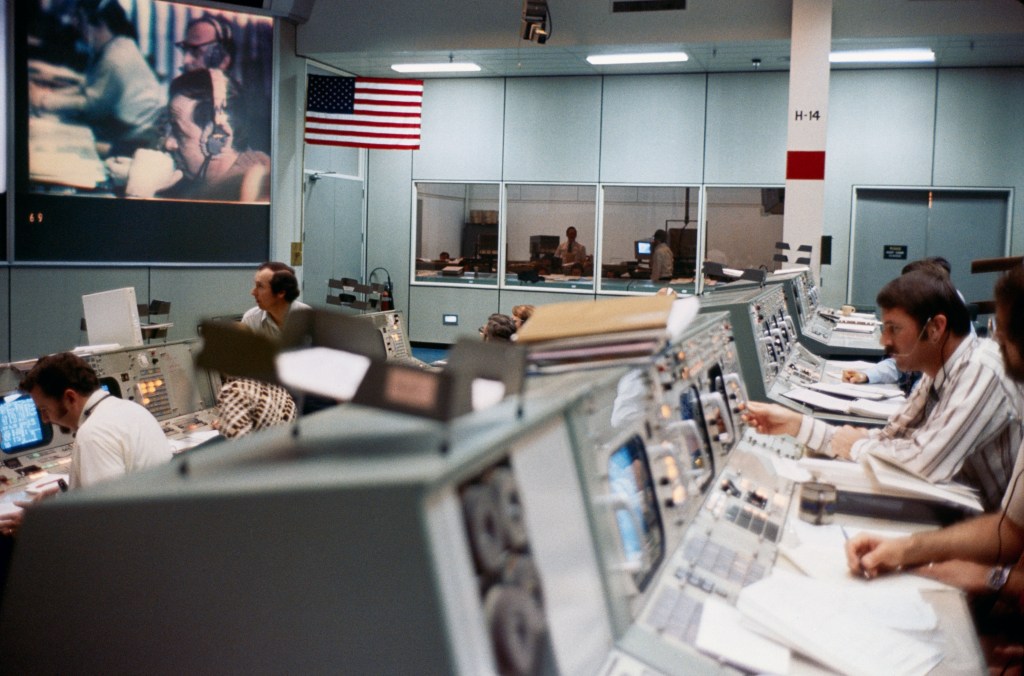 Mission Control in Houston during the joint simulation with Flight Director Donald Puddy in striped shirt and a view of Mission Control in Moscow on the large screen at left. NASA
Mission Control in Houston during the joint simulation with Flight Director Donald Puddy in striped shirt and a view of Mission Control in Moscow on the large screen at left. NASA 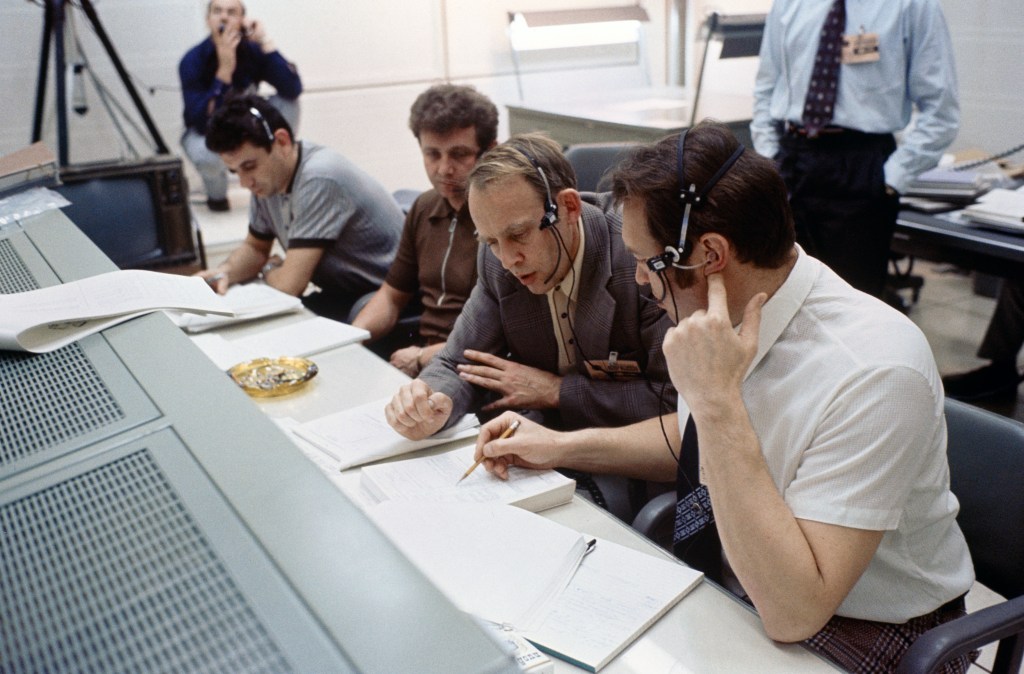 A group of Soviet flight controllers in a support room in Mission Control in Houston during the joint simulation. NASA On March 20, flight controllers and crews began a series of joint simulations for the joint mission scheduled for July 1975. For the six days of simulations, cosmonauts Aleksei Leonov and Valeri Kubasov and astronauts Stafford, Brand, and Slayton participated in the activity in spacecraft simulators in their respective countries, with both control centers in Houston and outside Moscow fully staffed as if for the actual mission. The exercises simulated various phases of the mission, including the respective launches, rendezvous and docking, crew transfers and joint operations, and undocking.
A group of Soviet flight controllers in a support room in Mission Control in Houston during the joint simulation. NASA On March 20, flight controllers and crews began a series of joint simulations for the joint mission scheduled for July 1975. For the six days of simulations, cosmonauts Aleksei Leonov and Valeri Kubasov and astronauts Stafford, Brand, and Slayton participated in the activity in spacecraft simulators in their respective countries, with both control centers in Houston and outside Moscow fully staffed as if for the actual mission. The exercises simulated various phases of the mission, including the respective launches, rendezvous and docking, crew transfers and joint operations, and undocking.
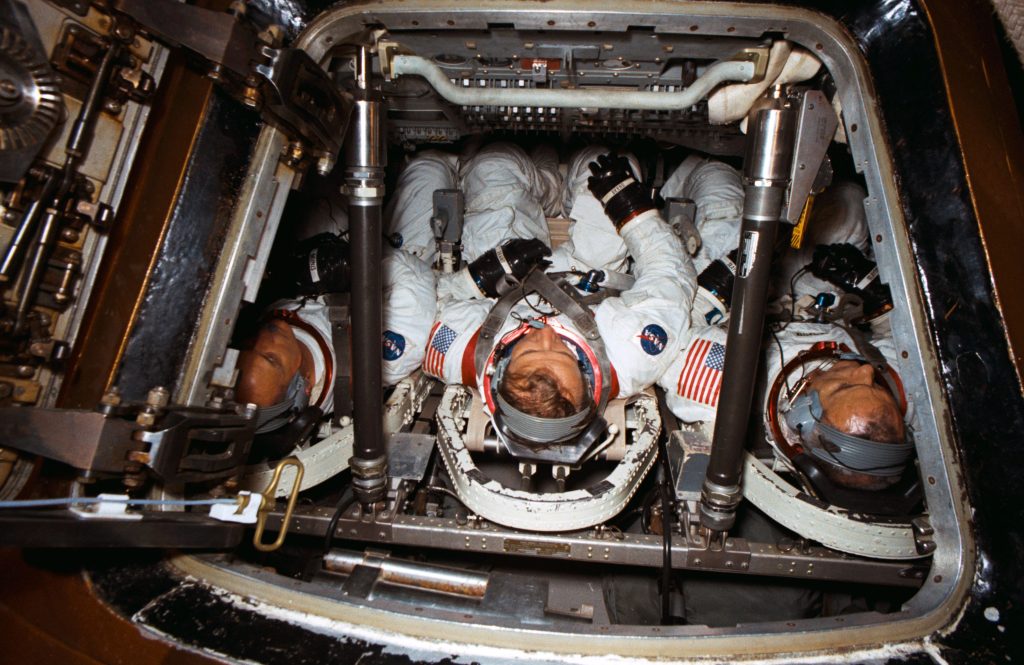 Astronauts Thomas Stafford, left, Vance Brand, and Donald “Deke” Slayton in a boilerplate Apollo command module preparing for the water egress training. NASA
Astronauts Thomas Stafford, left, Vance Brand, and Donald “Deke” Slayton in a boilerplate Apollo command module preparing for the water egress training. NASA 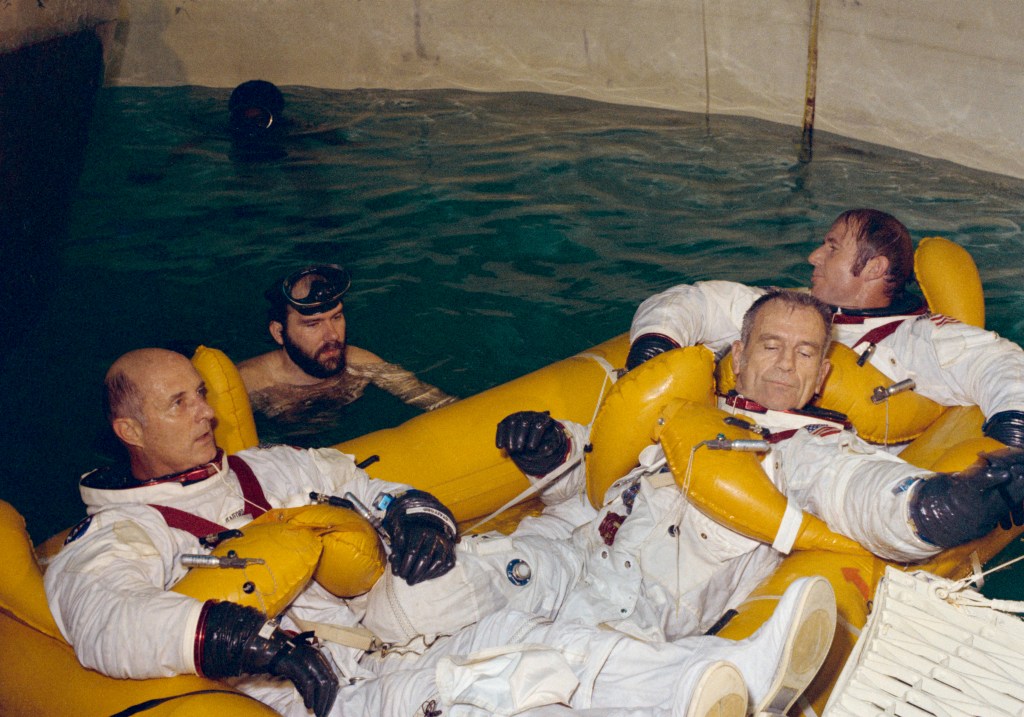 Stafford, left, Slayton, and Brand in the life raft during water egress training. NASA Astronauts Stafford, Brand and Slayton participated in a water egress training activity on March 8, completing the exercise in a water tank in Building 260 at NASA’s Johnson Space Center in Houston. The astronauts practiced egressing from their spacecraft onto a lift raft and being lifted up with the use of a Billy Pugh rescue net. They practiced wearing their flight coveralls as well as their spacesuits.
Stafford, left, Slayton, and Brand in the life raft during water egress training. NASA Astronauts Stafford, Brand and Slayton participated in a water egress training activity on March 8, completing the exercise in a water tank in Building 260 at NASA’s Johnson Space Center in Houston. The astronauts practiced egressing from their spacecraft onto a lift raft and being lifted up with the use of a Billy Pugh rescue net. They practiced wearing their flight coveralls as well as their spacesuits.

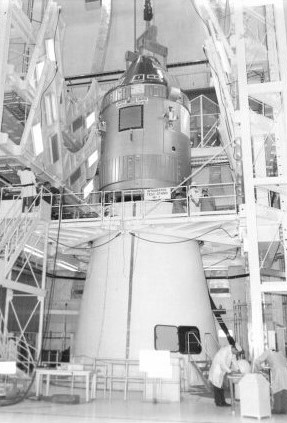
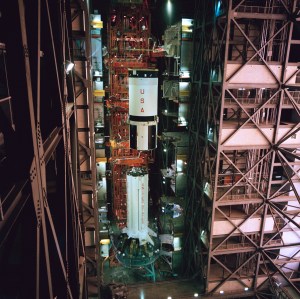 5 min read 50 Years Ago: Preparing the Final Saturn Rocket for Flight Article 2 months ago
5 min read 50 Years Ago: Preparing the Final Saturn Rocket for Flight Article 2 months ago  6 min read 45 Years Ago: Soyuz and Apollo Launch Article 5 years ago
6 min read 45 Years Ago: Soyuz and Apollo Launch Article 5 years ago  8 min read 45 Years Ago: Historic Handshake in Space Article 5 years ago
8 min read 45 Years Ago: Historic Handshake in Space Article 5 years ago 